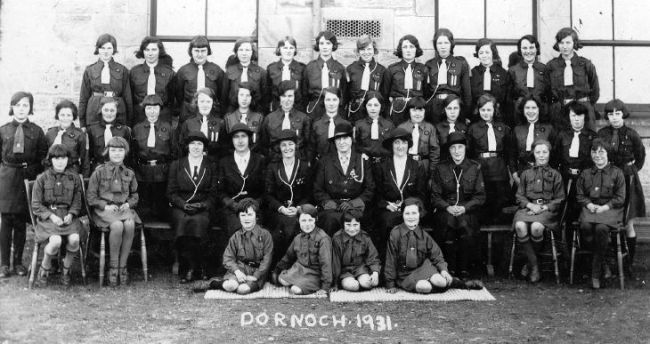This week’s post is written by Alison McCall who is a PhD student at the University of Dundee. She has a particular interest in career women in Victorian Scotland.
This photograph, from the Historylinks website, depicts a group of Dornoch Girl Guides in 1931. It is easy to overlook a photograph like this, as there must be thousands of well-nigh identical photographs of Girl Guide companies throughout Britain. However, two of Guide leaders here have fascinating stories. They were close friends, despite having led very different lives before coming to live in Dornoch.
 The leader seated fifth from the left was Miss Margaret C. Davidson. Margaret Davidson was born in 1879. Both parents were teachers, as were two of her maternal aunts. She attended St Andrews University, as did her younger sister, and after graduating went to Dornoch to teach modern languages in the Burgh School. When, during the First World War, the Scottish Women’s Hospitals were formed by Dr Elsie Inglis, she volunteered to go to Royaumont Hospital, France. She worked initially as an orderly, but subsequently became a nurse. In the porch of Dornoch Cathedral there is a brass Roll of Honour for the First World War, which includes the name of Nurse Margaret Davidson, M.A., S.W.H. She returned to her teaching career in Dornoch after the war, and by the time she retired she was head of the Modern Languages department. She continued to invigilate exams many years after her retirement, and died in 1978, aged 98.
The leader seated fifth from the left was Miss Margaret C. Davidson. Margaret Davidson was born in 1879. Both parents were teachers, as were two of her maternal aunts. She attended St Andrews University, as did her younger sister, and after graduating went to Dornoch to teach modern languages in the Burgh School. When, during the First World War, the Scottish Women’s Hospitals were formed by Dr Elsie Inglis, she volunteered to go to Royaumont Hospital, France. She worked initially as an orderly, but subsequently became a nurse. In the porch of Dornoch Cathedral there is a brass Roll of Honour for the First World War, which includes the name of Nurse Margaret Davidson, M.A., S.W.H. She returned to her teaching career in Dornoch after the war, and by the time she retired she was head of the Modern Languages department. She continued to invigilate exams many years after her retirement, and died in 1978, aged 98.
Also at Royaumont during the First World War was another Dornoch woman, Mrs Hacon. In the Guide photograph she is seated next to Margaret Davidson, sixth from the left. Mrs Hacon was a Roman Catholic and is not, therefore, included on the Dornoch Cathedral Roll of Honour. Mrs Hacon’s life story seems hardly credible when looking at her photograph, smartly dressed in her Guide Leader’s uniform. Her early life is a matter of conjecture. She claimed to have been born Edith Catherine Broadbent in 1874 or 1875, but I haven’t been able to trace a birth certificate. She variously claimed to have been the daughter of a painter, or the daughter of a doctor. What is clear is that in the early 1890s she was in London, working as an artist’s model and high class escort. She used the name “Amaryllis” when she was modelling and “Muriel” when she was working as an escort. She became the mistress of the novelist Arthur Symons, and he wrote several stories entitled “The Life of Lucy Newcombe” based on her account of her own life. In these accounts, she was brought up in an affluent home, orphaned, went to live with an aunt and uncle, but her elder cousin forced himself on her, she became pregnant and her aunt and uncle turned her out on the streets. The baby died. It’s impossible to say if this is true or not. At any rate she was mixing with the decadent group of Symons, Oscar Wilde, Aubrey Beardsley, and various others. The art patron William Llewellyn Hacon saw her portrait, admired it and asked to be introduced to her. They fell in love and married. From this point she used the name Ryllis Llewellyn Hacon. William Llewellyn Hacon loved golf, and built a home in Dornoch (now Oversteps Care Home).
As Mrs Hacon she became a society hostess, entertaining artists such as Toulouse Lautrec at their holiday home in Dieppe, and Charles Conder in Dornoch. This is a painting of her, entitled “On the Shore at Dornoch” painted by Conder in 1896. It now hangs in Aberdeen Art Gallery.
William Llewellyn Hacon died in 1910, leaving her a widow at 36. She threw herself into public life becoming involved in the suffrage campaign. She then went to Royaumont as an orderly or, as she preferred to describe herself “Head Char.” During the war she met a Canadian soldier, William Robichaud, and they married in 1918. She reverted to her original name of Edith Catherine. Margaret Davidson was one of the witnesses to the wedding. The Robichauds lived in Dornoch, adopted two boys and Mrs Robichaud was an active member of the community.
I wonder how many other Guide companies in 1931 could boast two such interesting Guide leaders?
